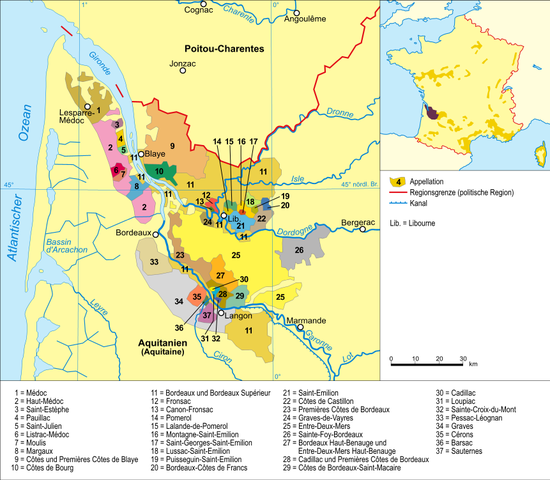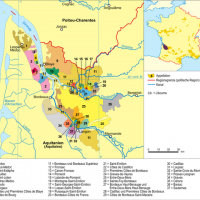I have been lucky enough to get an invite from a good friend that buys Bordeaux futures, or en primeur. His shipment of 2008 Left and Right Bank wines has arrived and we are chomping at the bit to examine them. Before diving into the information about the Chateaus and wines, I wanted to get your feet wet and your mind ready for Bordeaux. The following is an introduction to provide some background and foundation to the coming articles. Enjoy.
Bordeaux, France is well known for its high dollar, long-lived red wines and some rare whites that can be aged for over a century. Located on the western coast of France, the wine producing areas begin along the Gironde River and extend through the Gironde estuary and follow the Dordogne and Garonne Rivers east. The area boasts a maritime climate due to its proximity to the ocean and has a higher proportion of large estates than any other Frenc h wine region.
h wine region.
Looking with a rather simplistic view, Bordeaux can be subdivided into three large areas: Left Bank, Right Bank and Entre-Deux-Mers. The Left Bank refers to the area located to the west and south of the Gironde and Garonne Rivers. The Right Bank lies to the north and east of the Gironde and Dordogne Rivers. Finally, the much overlooked Entre-Deux-Mers is nestled between the Garonne and Dordogne Rivers.
In the Left Bank, we find three main further subdivisions: Medoc, Haut-Medoc, and Graves. The area north of Saint-Estephe is called Medoc. Here we see clay soil with outcroppings of gravel and home to Merlot, Cabernet Sauvignon, and Cabernet Franc. Similar to the Right Bank wines, yet unlike the other areas of the left bank, the Medoc wines are more predominantly Merlot. Also, note that there are no wines here that are ranked in the 1855 classification.
Starting at Saint-Estephe and running south, we have the area of the Haut Medoc. Here, the influence of the predominantly gravel soils encourage the growing conditions for the Cabernet Sauvignon vines, which dominate the blends. To a lesser degree, Merlot and Cabernet Franc are grown in the area. From north to south, we see such high reputation communes as Saint-Estephe, Pauillac, Saint-Julien and Margaux. The prestigious Haut-Medoc contains all but one red from the 1855 classification.
Just south of the city of Bordeaux and extending along the left bank of the Garonne is Graves. The predominantly gravel soils in the north, which helped to name this area, are prime for the Cabernet Sauvignon, Cabernet Franc and Merlot found here. Moving further south, the soils change, as do the grape varieties. This area’s sandy soils are more known for white wines created with Semillion and Sauvignon Blanc. In 1987 a northern portion of Graves was carved out to create a new appellation, Pessac-Leognan AC. This northern area of Graves contains the most famous properties, including the only 1855 classified first growth outside the Medoc, Chateau Haut-Brion. With all but one Chateau overlooked in the 1855 Classification, Graves created its own classification in 1959. Unlike the tiered structure we see in many other areas, this classification created a separate list of whites and reds that, through judged tasting, can earn the right to be called “Cru Classe”.
Moving to the Right Bank, we see more clay and limestone soil versus the gravel of the Left Bank. As expected with a change in soils, we see a change in the grape varieties. Here Merlot and Cabernet Franc dominate. Also unlike the Left Bank, the 1855 Classification does not exist here. Well known ACs such as Fronsac, Bourg, and Blaye are situated here, with Pomerol and Saint-Emilion having the most world-wide fame.
Saint-Emilion, one of the larger and more recognized areas of the Right Bank, has similarities and some unique attributes when comparing it to both the Left Bank and the rest of its Right Bank neighbors. Similar to most of Graves, it falls outside the 1855 Classification. For this reason, the area has developed its own tiered classification system, starting in 1955. Unlike many other regions, the AC structure here is attached to the specific land rather than to the Chateau. This AC-Vineyard connection is reclassified every 10 years based on tastings. The misleadingly prestigious sounding label of “Grand Cru” is rather easily attainable here. The title of Grand Cru Classe is held by about 55 properties, and only 11 made the Grand Cru Classe B category. The highest rank, Grand Cru Classe A, was attained by only Chateaux Cheval Blanc and Ausone.
The small, but well acclaimed, Pomerol is located north of Saint-Emilion and northeast of the town of Libourne. All of the vineyards, just under 2000 acres, are together on a large plateau with one holding being indistinguishable from the next. The soil is mostly gravel and clay but has a type of uniquely high iron-rich clay, appropriately called crasse du fer. Surprisingly, with famous names like Le Pin and Petrus, the area lacks any formal classification system.
I hope this introduction facilitates the understanding of the next few weeks of Bordeaux tastings. Along with the wine tasting notes, I will provide some information about the wine and specific locations. Further information can be found on the website located under the Bordeaux pages. Again, I welcome any feedback, corrections, or further information on these subjects. After all, life is about continued learning, and I feel most gratifying when we all play the role of teacher and student. Cheers!


 Masters of Wine
Masters of Wine Wine and Spirits Education Trust
Wine and Spirits Education Trust